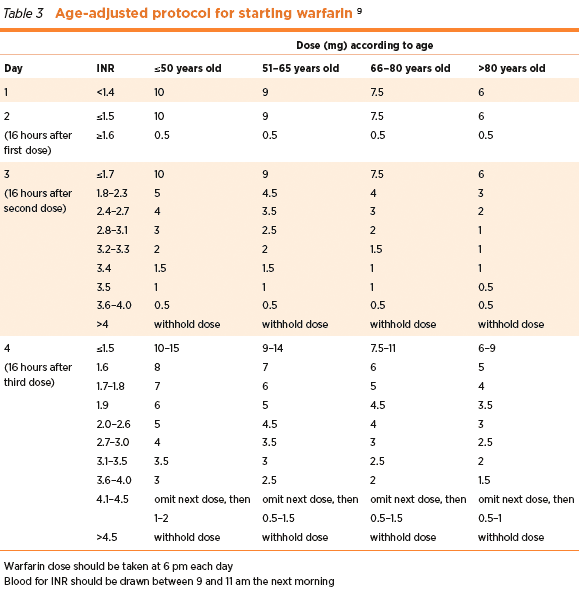

This lack of comparability is of special concern for patients who may use more than one laboratory for PT testing. While the PT is a common test for evaluating the coagulation of the patient, differences in thromboplastin reagents have caused problems when comparing results across laboratories. Recommended Therapeutic Ranges for Oral Anticoagulant Therapy An INR of 2.0 to 3.0 is recommended for all indications except mechanical prosthetic heart valves, for which an INR of 2.5 to 3.5 is recommended. The American College of Chest Physicians and the National Heart Lung and Blood Institute revised their recommendations for intensity of warfarin therapy in 1995. More frequent routine monitoring may be required in some patients. Periodic monitoring, up to once every month, is necessary as long as the patient remains on anticoagulation therapy. Alcohol, changes in diet, infections, liver disease, and other illnesses also can alter the patient’s PT/INR. Examples include estrogen, corticosteroids, barbiturates, carbamazepine, spironolactone and some antibiotics such as dicloxacillin, nafcillin and rifampin.Īny time a physician changes or adds medication to a patient’s regimen, the PT/INR should be checked to ensure that the patient maintains the proper level of anticoagulation. Other drugs can antagonize the effect of warfarin. Other examples include anticonvulsants, omeprazole, cimitidine, simvastatin, propylthiouracil, urokinase, streptokinase, amiodarone, thiazides, tricylclic antidepressants, danazol, and allopurinol. Analgesics including acetaminophen, aspirin and ibuprofen can prolong the PT. Other medications can affect the action of warfarin in the liver. Antifungal medications such as fluconazole, miconazole, norfloxacin and itraconzole can also prolong the PT. Examples include cephalosporins, ciprofloxacin, erythromycin, ofloxacin, sulfonamides, tetracyclines neomycin, chloramphenicol and metronidazole. One common cause of vitamin K deficiency is chronic administration of broad-spectrum antibiotics, which decreases the intestinal flora that synthesize vitamin K. It may take up to one month for a physician to reach an optimal therapeutic level of warfarin for an individual patient. However, until the patient reaches a steady state, PT/INR fluctuations are expected. Warfarin dosage changes may also be required in response to the PT/INR results. Typically, monitoring is performed daily, until several days after the therapeutic range is reached. Due to significant patient variability in response to warfarin therapy, the PT/INR must be closely monitored until a steady state has been reached. If administered on a daily basis, it usually takes 5-10 days for the warfarin level in the patient’s bloodstream to reach a steady state. Warfarin starts working in the liver within 24 hours, but the maximum effect of a single dose may not be seen for 2-4 days. Warfarin acts in the liver by inhibiting the synthesis of vitamin K dependent clotting factors, which include factors II, VII, IX and X, and other proteins essential for the clotting process. The prothrombin time may also be prolonged due to the presence of a coagulation inhibitor such as a specific factor inhibitor or the lupus anticoagulant. The prothrombin time may be prolonged by deficiency of a single or multiple coagulation factors (Factor VII, Factor X, Factor V, Factor II or fibrinogen). Determine the etiology of abnormal bleeding.Prior to intravascular cardiac surgery or other procedures that interfere with coagulation.Investigate a history of a bleeding tendency prior to invasive surgical procedures.Physicians may request a PT any of the following reasons: However, the presence of excessive heparin (sample collected shortly after a heparin bolus, collected above the site of a heparin infusion or from a heparin coated catheter) may overwhelm the neutralizer and prolong the PT because of its inhibitory effect on thrombin. Heparin neutralizers, such as Polybrene, are added to PT reagents and can neutralize up to 2 U/mL of heparin. PT reagents are more sensitive to Factor VII deficiency than to deficiencies of factors V, X, prothrombin and fibrinogen. The PT assesses the coagulation factors of the extrinsic pathway (factors VII) and the common pathway (activated factor X, activated factor V, prothrombin and fibrinogen).

Inr normal range 4 Activator#
The prothrombin time (PT or protime) is the actual time, measured in seconds, for an anticoagulated sample of patient plasma to clot after the addition of calcium and an activator of the extrinsic pathway, which is called thromboplastin.


 0 kommentar(er)
0 kommentar(er)
